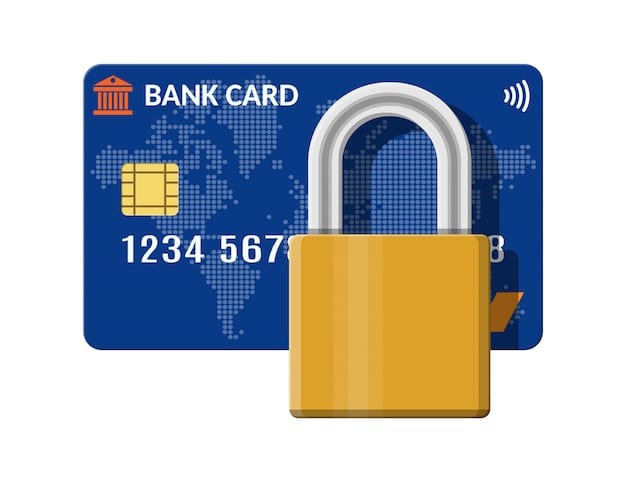Avoid Payment Processing Mistakes: US E-commerce Checklist

Avoiding common payment processing mistakes is crucial for US e-commerce businesses to ensure smooth transactions by implementing a robust checklist that addresses security vulnerabilities, compliance requirements, and customer experience enhancements.
For US e-commerce businesses, avoiding common payment processing mistakes: a checklist for US e-commerce businesses to ensure smooth transactions is essential for maintaining customer trust and profitability. Understanding the nuances of payment processing can save you from costly errors and enhance your business’s reputation.
Understanding Payment Processing in the US E-commerce Landscape
Payment processing is the backbone of any successful e-commerce business in the United States. It involves the secure transfer of funds from the customer to the merchant. However, navigating this process can be complex, with numerous potential pitfalls that can lead to lost revenue and dissatisfied customers.
From choosing the right payment gateway to ensuring PCI compliance, understanding the intricacies of payment processing is paramount. Let’s delve into some of the key aspects that US e-commerce businesses should consider.
Choosing the Right Payment Gateway
Selecting the appropriate payment gateway is a crucial first step. A payment gateway acts as the intermediary between your website and the payment processor, securely transmitting transaction data. Factors to consider include transaction fees, supported payment methods, integration ease, and security features.
Key Considerations for US E-commerce Businesses
- Transaction Fees: Compare the transaction fees charged by different gateways to find the most cost-effective option for your business.
- Supported Payment Methods: Ensure the gateway supports the payment methods preferred by your customer base, such as credit cards, debit cards, and digital wallets like PayPal and Apple Pay.
- Integration Ease: Choose a gateway that integrates seamlessly with your e-commerce platform to avoid technical issues and streamline the checkout process.
- Security Features: Prioritize gateways that offer robust security features like tokenization and fraud detection to protect customer data and prevent fraudulent transactions.
By carefully evaluating these factors, you can select a payment gateway that aligns with your business needs and provides a secure, efficient payment experience for your customers.
Ensuring PCI Compliance to Protect Customer Data
PCI DSS (Payment Card Industry Data Security Standard) compliance is not just a recommendation—it’s a requirement for any business that handles credit card information. Non-compliance can lead to hefty fines and damage to your business’s reputation.
Following PCI compliance standards demonstrates your commitment to protecting sensitive customer data. Let’s explore essential steps to ensure your business meets these standards.

Understanding PCI DSS Requirements
The PCI DSS outlines 12 key requirements to protect cardholder data. These requirements cover areas such as network security, data encryption, and access control. Staying up-to-date with the latest PCI DSS guidelines is essential.
Steps to Achieve PCI Compliance
- Assess Your Systems: Conduct a thorough assessment of your payment processing systems to identify vulnerabilities and areas for improvement.
- Implement Security Controls: Implement security controls such as firewalls, intrusion detection systems, and encryption to protect cardholder data.
- Regular Monitoring: Continuously monitor your systems for security breaches and vulnerabilities, and take prompt action to address any issues.
- Employee Training: Provide regular training to your employees on PCI DSS requirements and best practices for handling cardholder data.
Achieving and maintaining PCI compliance is an ongoing process that requires vigilance and commitment. By adhering to these standards, you can safeguard your customers’ data and maintain their trust.
Optimizing the Checkout Process for a Seamless Customer Experience
The checkout process is a critical touchpoint in the customer journey. A cumbersome or confusing checkout experience can lead to abandoned carts and lost sales. Optimizing this process is vital for enhancing customer satisfaction and driving conversions.
A smooth, intuitive checkout process not only reduces cart abandonment but also encourages repeat business. Let’s explore proven strategies to optimize your checkout process.
Simplifying the Checkout Process
Streamline the checkout process by minimizing the number of steps required to complete a purchase. Reduce form fields to only essential information and offer guest checkout options to expedite the process.
Strategies to Improve Checkout Conversion
- Clear and Concise Instructions: Provide clear and concise instructions at each step of the checkout process to guide customers through the transaction.
- Multiple Payment Options: Offer a variety of payment options to cater to different customer preferences, including credit cards, debit cards, and digital wallets.
- Mobile Optimization: Ensure your checkout process is fully optimized for mobile devices to provide a seamless experience for mobile shoppers.
- Security Badges: Display security badges and trust seals to reassure customers about the security of their payment information.
By implementing these strategies, you can create a checkout experience that is both efficient and user-friendly, leading to increased customer satisfaction and higher conversion rates.
Addressing Chargebacks and Fraud Prevention
Chargebacks and fraudulent transactions are costly challenges for e-commerce businesses. A chargeback occurs when a customer disputes a transaction, while fraud involves unauthorized use of payment information. Implementing robust fraud prevention measures is critical to protect your business.
Effective chargeback management and fraud prevention not only save money but also protect your business’s reputation. Let’s explore key strategies to mitigate these risks.

Implementing Fraud Detection Tools
Utilize fraud detection tools to identify and prevent fraudulent transactions before they occur. These tools analyze various data points to detect suspicious activity and flag potentially fraudulent orders for review.
Best Practices for Chargeback Management
- Address Verification System (AVS): Implement AVS to verify the billing address provided by the customer matches the address on file with the credit card issuer.
- Card Verification Value (CVV): Require customers to enter the CVV code to verify they have physical possession of the credit card.
- Transaction Monitoring: Monitor transactions for suspicious patterns, such as unusually large orders or multiple orders from the same IP address.
- Clear Return Policy: Maintain a clear and easily accessible return policy to minimize disputes and chargebacks.
By proactively managing chargebacks and implementing fraud prevention measures, you can protect your business from financial losses and maintain a secure payment environment.
Mobile Payment Optimization for a Growing Mobile Audience
With the increasing use of mobile devices for online shopping, optimizing your payment process for mobile is essential. A mobile-friendly payment experience ensures that customers can easily complete purchases on their smartphones and tablets.
Optimizing for mobile payments enhances the customer experience and drives conversions. Let’s examine strategies to ensure your payment process is mobile-friendly.
Responsive Design and Mobile-Friendly Layouts
Ensure your website uses a responsive design that adapts to different screen sizes. A mobile-friendly layout should be easy to navigate and provide a seamless experience on smaller screens.
Strategies for Mobile Payment Optimization
- Simplified Forms: Use simplified forms with auto-fill options to minimize the amount of typing required on mobile devices.
- Mobile Payment Options: Offer mobile payment options like Apple Pay and Google Pay to enable quick and convenient checkout.
- Fast Loading Times: Optimize your website for fast loading times to prevent customers from abandoning their carts due to slow loading speeds.
- Touch-Friendly Buttons: Use touch-friendly buttons and controls that are easy to tap on mobile devices.
By optimizing your payment process for mobile devices, you can cater to the growing mobile audience and provide a seamless shopping experience that drives conversions.
The Importance of Recurring Billing and Subscription Management
For businesses that offer subscription-based services, managing recurring billing effectively is crucial. Streamlining the subscription management process ensures timely payments and reduces customer churn.
Efficient recurring billing processes enhance customer retention and improve cash flow. Let’s explore best practices for managing subscriptions.
Automated Billing Systems
Implement automated billing systems to process recurring payments automatically. These systems ensure that payments are collected on time and reduce the risk of missed payments.
Strategies for Subscription Management
- Flexible Subscription Options: Offer flexible subscription options to cater to different customer needs and preferences.
- Automated Payment Reminders: Send automated payment reminders to customers before their subscriptions renew to reduce involuntary churn.
- Easy Subscription Management: Provide customers with easy access to manage their subscriptions, including the ability to update payment information and cancel subscriptions.
- Subscription Analytics: Track subscription metrics such as churn rate and customer lifetime value to identify areas for improvement.
By implementing these strategies, you can optimize your recurring billing process, enhance customer retention, and drive long-term revenue growth.
Conclusion
Avoiding common payment processing mistakes: a checklist for US e-commerce businesses to ensure smooth transactions requires attention to detail and a commitment to best practices. From choosing the right payment gateway to ensuring PCI compliance and optimizing the checkout process, each aspect plays a crucial role in providing a secure and seamless payment experience for your customers. By implementing the strategies outlined in this checklist, US e-commerce businesses can minimize risks, enhance customer satisfaction, and drive growth.
| Key Point | Brief Description |
|---|---|
| ✔️ PCI Compliance | Ensuring adherence to data security standards. |
| 🛒 Optimize Checkout | Simplifying the payment process for customers. |
| 🛡️ Fraud Prevention | Implementing tools to detect fraudulent transactions. |
| 📱 Mobile Payments | Optimizing payment process for mobile devices. |
FAQ
▼
PCI compliance is essential for protecting customer data and avoiding hefty fines. By adhering to PCI DSS standards, businesses demonstrate their commitment to data security, building trust and safeguarding sensitive information.
▼
To optimize the checkout process, simplify forms, offer multiple payment options, ensure mobile optimization, and display security badges. These steps make purchasing easier and quicker, reducing checkout abandonment and improving conversions.
▼
Businesses can prevent fraud by using fraud detection tools, implementing AVS and CVV verification, monitoring transactions for suspicious patterns, and maintaining a clear return policy. These measures help identify and block fraudulent orders.
▼
Mobile payment optimization is crucial because an increasing number of customers shop on mobile devices. A mobile-friendly payment experience ensures easy completion of purchases, enhancing customer satisfaction and increasing revenue.
▼
Recurring billing is essential for subscription businesses as it ensures timely payments, reduces customer churn, and improves cash flow. Automated systems, flexible options, and effective communication enhance customer retention.
Conclusion
By addressing each of these critical areas, e-commerce businesses in the US can create a secure, efficient, and customer-friendly payment processing system. This, in turn, leads to increased customer satisfaction, fewer transaction issues, and a stronger bottom line.





